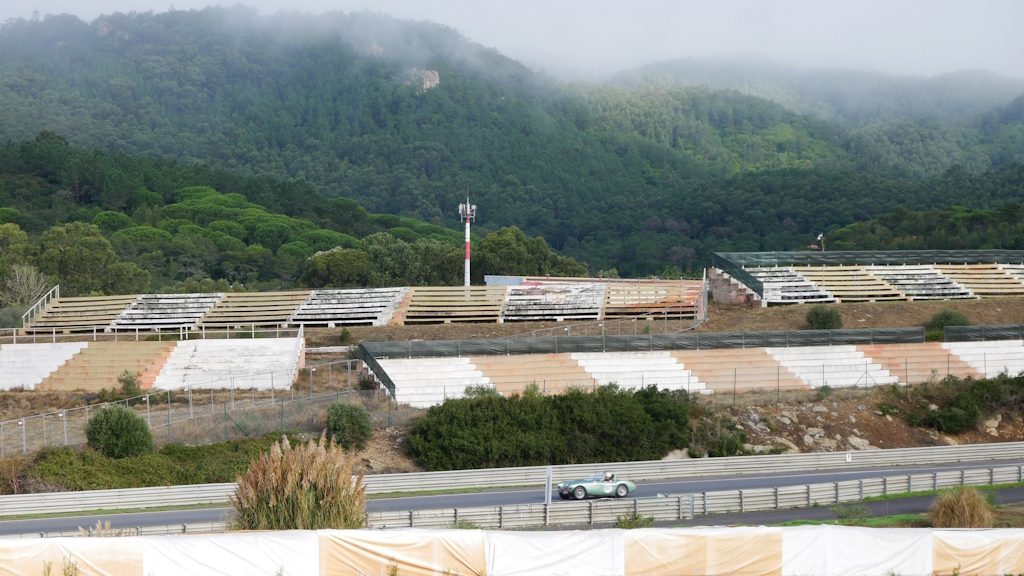Column: Why I May Have Judged Estoril Too Quickly

[ad_1]
The Portuguese Grand Prix has had an on-off relationship with Formula One throughout its history. From 1984 to 1996, however, it was held every year, namely at the Autodrómo do Estoril – a track that I highlighted in an article earlier this year, diving into the track’s and the event’s history a bit.
Once F1 had left due to the track failing to enact modernization requests, Estoril finally did get a makeover in time for the 1999 season, but F1 would never return. The layout, as I argued in the original article, was not exactly an improvement, with several corners being altered, slowed down or slightly reprofiled. The result: a track that flowed less than previously.
These days, Estoril does not see much international action, with the biggest exception being the Superbike World Championship. The Autódromo does hold an FIA Grade 1 license, though, and when planning a trip to Lisboa recently, I stumbled upon the Estoril Classics event. If you regularly read or watch OverTake’s content, you will know that this was right up my alley.
The foggy hills made for a scenic backdrop, to say the least.
Legendary Cars From The Past
With the track being situated just outside Lisbon, getting tickets was a no-brainer. And it was very much worth it. General admission to an event like this is always exciting, as you can get close to the cars like nowhere else, walking into the garages and even pit lane to really check out your historical favorites from up close. If you have never been to a motorsport event, I highly recommend a historic one to get a really close look!
The event had sports cars from pretty much any decade from the 1950s to the 2000s, with the newest cars running there being the likes of two Maserati MC12s, an Aston Martin DBR9 or a Saleen S7R. The most modern vehicle there was a 2010 Corvette C6.R. Other highlights included not one, but two 1976-spec Tyrrell P34 six-wheelers (although one of them was apparently a replica, albeit authorized by Tyrrell), two BMW M1 Procar, a bunch of Ford GT40s, an Alfa-Romeo 182 F1 car, a Lotus 72 and a 78… I could go on forever, it seems.
With a line-up like that, it was clear that the Friday we intended to visit would be spectacular. Adding to this was the fact that the schedule also included a slot for 1990s F1 car demo runs – hearing one of the V10 cars of the time in person has been on my bucket list for the longest time, and even more so since I had missed two opportunities in the span of just over a year before the event.
One of two Tyrrell P34s at Estoril Classics – possibly the most unconventional F1 car of all time.
The Ongoing Quest Of Hearing A V10 F1 Car In Person
Attending the NLS 12h in September 2023 at the Nürburgring, the Red Bull Formula event packed the place, and one of the cars was Ralf Schumacher’s 2003 Williams F1 car, driven by the man himself. The event advertised bringing back F1 cars to the Nordschleife – which it did, but not the 940-horsepower FW25, unfortunately. Sadly, this was not communicated ahead of time. Guess who had already posted up at Aremberg to see the thing fly by?
After this letdown, you can probably imagine the joy I felt when we found the FW22 and FW19 cars sitting in the pits at Silverstone when @Michel Wolk and I went there to meet Straight4 Studios and GIANTS Software. Both of the cars did run that day – but only about half an hour or so after we had to leave to catch our flight home. Rats.
Estoril seemed like a safe bet this time. No leaving early, no parts of the track where you would miss them if you were there – and yet, no 90s F1 cars ran that Friday, either. I spotted two of them, a 1990 Brabham BT59 (powered by a V8, of course), and a 1993 Tyrrell 021 – and the Brabham returning to the pits on the bed of a tow truck after an open practice session for all F1 cars present (having completed zero laps) probably was the nail in the coffin for the 90s demo – not much fun with just one car was the reasoning behind it, I would guess.
Modern Track Meets Not-so-modern Surroundings
Anyway, the event still had a nice surprise in store – namely the track itself. And I do not mean the layout either – I still think that it was much better before the rework, although not as safe, of course. It was more about the vibe of the place itself, which has an interesting duality.
While the circuit itself looks nice and modern, the surroundings do not. While the pit buildings have been part of the late 90s modernization effort, it has been 25 years now, so they look a bit dated, too. The other surroundings, including the main grandstand, have that distinct feel of having seen all F1 races from 1984 to 1996, though.
Estoril originally opened in 1972, but was upgraded significantly to attract the Grand Prix circus for 1984. The grandstand must be at least 40 years old, I thought, and that is correct – because it was already in place when the track opened according to a 2022 Jornal Dos Classicos article on the 50th anniversary of the track.
Yours truly while trying to photo hunt with Parabólica Interior in the background.
Lost Place Feel Overlooking The Final Sector
Where things got really weird in a good way was when we headed to the grandstands between Parabólica Interior and Gancho, overlooking much of the track. It was a bit like a portal through time, as silly as that may sound, but walking through a pedestrian tunnel that has clearly seen better days does its part for this impression. It felt a bit like entering a lost place.
The fact that hardly any spectators made the trek to those grandstands probably added to it, as there was no way to reach them via the paddock. You had to exit the track and walk around the main straight and Parabólica Ayrton Senna on the outside, then re-enter via the aforementioned tunnel – a good 15-minute walk.
We were then greeted by a bunch of old concrete grandstands, some even closed off because they were starting to fall apart. Concrete slabs that were bending, rusty handrails, a little house containing restrooms that probably also saw Ayrton Senna’s first GP win in 1985 at the track. Coupled with the hills surrounding the track disappearing into a thick fog and a modern track running right through the middle of all this made it a bit surreal. But also quite cool.
Breathing History
It was one of those experiences where you could breathe the history of a place, and not because it was well-preserved as it was, but rough and ragged – like a lost place, except it is not one. I could not help but imagine what it must have been like with the likely enormous crowds that saw the 1980s GPs here, or the 1977 World Sportscar Championship round. How they must have reacted when Riccardo Patrese completed his infamous 1992 flip on the main straight, narrowly missing a bridge that crossed the track and emerging unhurt. Or Jacques Villeneuve’s daring outside pass on Michael Schumacher at Parbólica Ayrton Senna in 1996.
In a way, it made the track’s history more tangible somehow. That probably would not be the case if the track had modern grandstands and buildings everywhere, so in a way, it was a great setting for Estoril Classics – despite the layout not matching what most of the cars would or could have raced back in their day.
Do I like the layout itself more as a result? Not really. But that visit to Estoril certainly gave me an entirely different appreciation of the venue, so I might enjoy running the modern version of the track in sim racing a lot more. I guess visiting certain racing tracks in person will do that.
Have you ever been to Estoril or did visiting a track change your mind about it, too? Let me know your opinions and experiences in the comments below!
[ad_2]
Nota: El contenido ha sido traducido por Google Translate, por lo que algunos términos pueden ser imprecisos
Fuente: https://www.overtake.gg/news/column-why-i-may-have-judged-estoril-too-quickly.2495/
